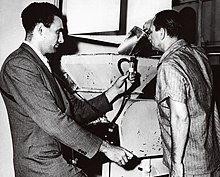 An industrial hygienist takes an air sample in the breathing zone of an industrial worker in 1951 | |
| Agency overview | |
|---|---|
| Formed | 1914 |
| Dissolved | 1971 |
| Superseding agency | |
| Jurisdiction | Federal government of the United States |
| Headquarters | Pittsburgh (1914–1918) Washington, D.C. (1918–1938, 1947–1966) |
| Parent agency | Hygienic Laboratory (1914–1918) Division of Scientific Research (1919–1937) |
| Footnotes | |
| Names Office of Field Investigations into Occupational Diseases (1914–1917) | |
The Division of Industrial Hygiene was a division of the U.S. Public Health Service (PHS) with responsibility for occupational safety and health programs. It existed from 1914 until 1971, when it became the National Institute for Occupational Safety and Health (NIOSH). It had several names during its existence, most notably the Office of Industrial Hygiene and Sanitation in its earlier years and the Division of Occupational Health during its later years.
It was established as a result of Progressive Era concerns for the conditions of workers, with the goal of providing scientific responses to hazards faced in the workplace. It was headquartered for its first few years in the Pittsburgh U.S. Marine Hospital, and moved to Washington, D.C. in 1918. Its responsibilities expanded during World War I, and during the 1920s its functions grew to include broad field studies integrating environmental analyses of hazards in workplaces with medical analyses of workers' health.
In 1937, it became a division of the National Institute of Health. The following year the Industrial Hygiene Laboratory, the first building built solely for the study of industrial hygiene in the U.S., opened as one of the first three buildings of the new NIH campus. The outbreak of World War II caused a shift away from field investigations to direct services to the U.S. Army Ordnance Department and state agencies to keep workers safe for war production, as well as an increase in laboratory research and development of analytical instrumentation.
The Division was moved into the new Bureau of State Services in 1943 as part of a reorganization of PHS, although the laboratory research programs were split off and remained in NIH. In 1950, its field operations moved to Cincinnati to co-locate with the PHS Environmental Health Center already established there. During the 1950s, its funding and activities were greatly reduced, and it was downgraded from division status, but in 1960 it was restored as a division and began to grow again.
An effort to build support for a national occupational health program culminated in the 1965 Frye Report, which recommended that the Division be given specific legislative authority and increased funding. However, the PHS reorganizations of 1966–1973 were particularly turbulent for occupational health programs, as the organization passed through seven operating agencies and bore four names during this time. Nevertheless, the Federal Coal Mine Health and Safety Act of 1969 give PHS national responsibility for medical research and examinations, its first legislatively mandated activity in occupational health. The Occupational Safety and Health Act of 1970 created NIOSH from the former Division.
© MMXXIII Rich X Search. We shall prevail. All rights reserved. Rich X Search
